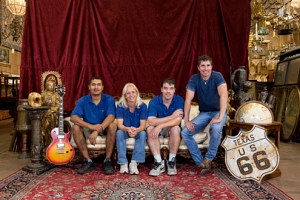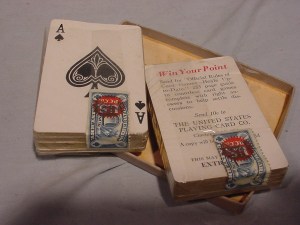When I saw this photograph of Wink, the vintage fashion collector and seller, the first thing I thought was, “Wow, vintage fans really blow her skirts up!” The second thing I thought was, “What a ‘cool’ thing to collect!”
And then, nearly out of puns (“She has created her own ‘Fan Club!'”), I realized I wanted to be a bit more serious and talk to her about her collection of vintage fans.
Wink, describe your fan collection. What do you look for in a fan? Is there a time period, manufacturer, size, color or other specific thing you look for?
My “fan club” consists of seven electric fans of varying vintage. I’m a graphic designer by trade, so I tend to notice the brand badges in addition to the industrial design of the fan.
For collecting purposes, I don’t pay much attention to the brand, or color, or period… I just go for whatever catches my eye. That being said, I’ve been a fan of the “atomic future” shapes of the 1950s for about as long as I can remember, and I suspect that most of my fans date to that general time frame.
Do the fans have to work? Do you repair them? If so, do you do it yourself, or pay a professional? (Or, option three, make a spouse do it lol)
Six of the fans work, although the oscillating fan no longer oscillates. One that had been a catalog stylist’s prop and was gifted to me has a cut cord, and I’ve never bothered to splice a new plug on. I could, though! If the motor is blown, though, that’s beyond my own skill set. I might pass it off to a mechanically-inclined friend and bat my eyelashes, but it’s really not important to me that one isn’t working.
When buying, though, I’ll do a function test on-site if it’s possible. Which is kind of funny, really, because I never use any of them for their intended purpose!
Aside from your personal budget, do you pay attention to the monetary or book value of fans?
None whatsoever.
I buy what I like, and the most I’ve spent is $20 so I decided that was my personal, if random, limit. I could easily go higher, and I know that I’ve been very lucky both with my own finds and with the friends who have given me a few as gifts.
When my collection was younger and smaller I tried looking up the value of what I then had, but it was a cursory search and really. I just buy them because they look cool. It’s not an investment thing, like clocks or rugs would be.
What made you become a fan of fans — decide to collect fans?
I bought my first fan for $1 at a garage sale. (Well, the seller was asking 75¢ and tried to give me 25¢ change but I told her to keep it.) That was a blue Coronado, and I bought it because I loved the shape.
Then I bought a second at an antiques mall, and my third (the non-oscillating one) at a flea market. That was when I came up with, “Two is a coincidence. Three is a collection.” Talk about a rationalization!
How many fans are in your collection?
A mere seven, but they take up space!
How do you display your fan collection?
I used to have them up on wall-mounted shelves in the living room, but a few years ago I bought an “entertainment center” that has six cubbies which are perfect for displaying items approximately fan-sized. The seventh fan sits on top of the TV. If/when I get more, there’s a shelf that’s supposed to go along the top which can hold perhaps five or six similarly-sized fans.
Fans are larger and their shape makes them less efficiently organized than say books or some other collectible… Does their size limit your collection?
Most definitely. I had to set an artificially low budget for myself so that I won’t obsess over searching for them, or my house would fill up. They’re definitely out there if you’re looking!
Instead, I made an Etsy treasury of electric fans for other people, and tried for a while to replace listings as they sold. As the treasury got older, it wasn’t getting new views so I stopped updating it. I can’t bear to take it down, though, so perhaps it’s time to refresh it!
Do fans have many fans? lol In other words, when you are at auctions, flea markets, do you find yourself competing with many other collectors for the fans?
There do seem to be a few collectors out there, but since I go for looks/price and not book value, I don’t know if we’re hunting for the same things. Shipping expenses will often blow my budget out of the water, so I tend to look locally. I’ve never had anyone try to pry a fan out of my hands at the antiques mall! LOL!
How do people react to your collection of vintage fans?
The fans are clearly on display in my living room, which is the first room in the house. People who know me are used to seeing them (the collection started somewhere around 10 years ago), but new friends notice them right away and usually let out with a “Oooh, I like your fans!” They’re like sculptures for the common man!
Do you collect brochures, advertisements, packaging etc., or just the fans themselves?
Just the fans, although I wouldn’t be opposed to buying printed ephemera if the price was right and it had some display value.
Do you collect anything that you’d consider related to fans — other small appliances or some such?
I’m a clutterbug. Is that a word? It is now. I collect, actively or passively, a lot of things. Fans are the only electric appliances, though!
Given your youthful appearance, I gather the fans are much older than you are and so they do not carry a sense of real life nostalgia for you… Is there anything you’d like to say about your affection for their “atomic” appeal?
Why, thank you! Yes, I imagine all of the fans are older than I am. However, I grew up in a family of thrifty folks who typically didn’t throw away or replace anything that was still useful, so this is the kind of fan that my grandmother or great aunt would have had in their houses.
My dad had an industrial-strength window fan in his home office that was probably similar in style, although I don’t quite remember its looks as much as I remember its ability to wreak havoc with his paperwork if we accidentally shut his office door! As a family, we spent many weekends watching ’50s sci-fi and film noir flicks on the television, so I’m sure I grew accustomed to this style in that way as well.
Then again, I’m still grumpy that the Dodgers moved to L.A., even though Ebbets Field was torn down before I was ever born! It’s difficult to explain some of the things I’m sentimental about.
Isn’t that true for some many of us.
You can keep up with Wink at her blog, Shoes and Pie, and become a “fan” of her Etsy store at FaceBook.
Photographs of Wink with her Fan Club taken by Candy Apple Photography. (Caution: Candy Apple Photography website plays music — so don’t try to sneak in at work, unless you’ve got your sound off!)





























































































